Squadron disaster. Project K Submarines (UK)
Shape formation
The concept of a squadron submarine had several unusual features. It was assumed that the boats will go to the area of sea battles in the same system with surface ships. Before the battle, they should dive and continue to work in a submerged position. The objectives of the squadron submarines were to be the enemy’s rear guard or other ships of value or danger.
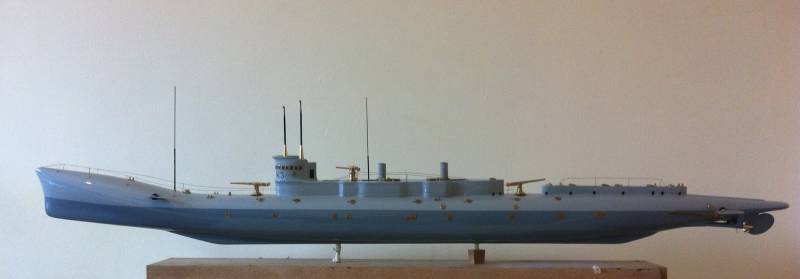
The layout of the submarine HMS K3 - the first representative of the project "K", taken to the service. Photo Sshipyard.blogspot.com
In 1913, during the regular maneuvers of the Royal Navy fleet A training battle took place, the purpose of which was to test the actions of mixed squadrons, including both surface and submarine ships. The exercises showed the theoretical viability of the new concept and some of its advantages. At the same time, it was found that existing submarines cannot solve problems in mixed compounds. They lacked the speed of the surface and underwater course, lacked reliable means of communication and identification, and also had a host of other problems.
However, the exercises were recognized as successful, and the Admiralty embarked on the further development of the proposed concept. The existing submarines could not be used as squadrons, and therefore the command decided to develop a completely new model. Taking into account the experience of the training maneuvers, tactical and technical requirements for the advanced design of the squadron submarine were formed. According to this assignment, a new project should have been developed and then mass construction of machinery should be organized.
First of all, the new submarine required high speed. The existing submarines with a diesel-electric power plant were accelerated only to 15-17 units, which was not enough to interact with surface ships. The new submarine was supposed to reach speeds up to 22-24 nodes. It should be equipped with several torpedo tubes, preferably with the possibility of firing in different directions. There were also other requirements related to various parties to the service.
The new project of the submarine designated the letter "K". Preliminary study showed that existing and future diesel-electric systems will not give the desired characteristics. The required speed could be obtained only when using a power plant based on steam boilers and turbines, which is not typical for a submarine fleet. For greater reliability, they decided to supplement the boiler and turbine unit with a backup diesel-electric one. The design of boilers, turbines and other elements of the power plant set new requirements in the context of ship design.
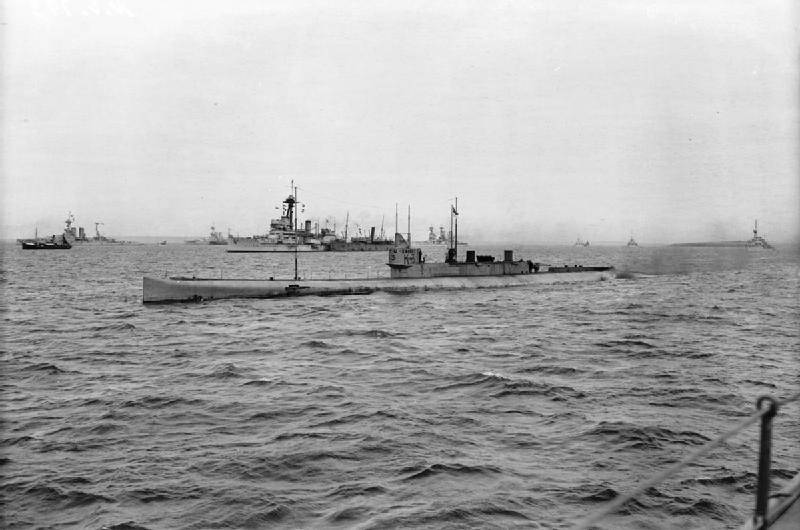
K3 after completion and removal of the upper nasal torpedo tubes. Photo of the Imperial War Museum / iwm.org.uk
Project K
The development of the project was entrusted to the Admiralty Shipbuilding Division. Eustace Tennyson-d'Einkert was appointed chief designer. In the middle of 1915, the new project “K” was ready. Given the special requirements and specific technical specifications promising submarines should have been seriously different from existing ones. First of all, the new ships turned out much larger and heavier than the serial ones. The need to increase the size and displacement was due to the use of boilers and turbines, which occupied a lot of space inside the robust hull. Also required volumes for backup diesel generator, advanced weapons and other units.
The K-class submarine had a two-part design with an internal robust body, outside closed light design. The lightweight body had a vertical stem and diverging sides. Provided horizontal deck with protruding chopping and superstructure. At the last were two folding chimneys. Under the bottom provided a pronounced keel. Stern tip designed in the form of a cone with protruding supports for screws and rudders. Outside the light housing were some units, including some of the weapons. Initially, the light body had a characteristic battered nose, which was a fairing of additional torpedo tubes. She was later abandoned.
The solid hull was divided by bulkheads into nine compartments of different sizes. The first torpedo compartment was placed in the nose, behind which the living space for officers was placed. Behind him was the main post with the wheelhouse. The fourth compartment was given under torpedo armament. 5 and 6 compartments contained boilers and steam turbines, respectively; above them was installed superstructure with pipes. The backup diesel generator and electric motors were located in the seventh compartment. The eighth compartment was residential and was intended for the sailors, and in the ninth there was a second cabin and steering mechanisms.
The specific composition of the onboard equipment affected the hull design. Engineers had to sacrifice the strength of the power set, because of which the working depth was reduced to 50-55 m. For this parameter, the submarine "K" almost twice lost to other submarines of its time.
In the fifth boiler compartment were placed two oil boilers, as well as all auxiliary systems and part of the tanks with fuel. It was proposed to transfer steam from boilers through pipelines to the sixth compartment and feed them to two turbines. The air for the boilers flowed through the vents and the piping system. Combustion products were removed through a pair of chimneys raised above the superstructure. Before immersion, the pipes had to be folded and placed in the superstructure niches.
Different boats of the project "K" received turbine units from the firms Brown-Curtis or Parsons. In both cases, the turbines showed power 10500 hp. After a couple of gearboxes and shafts, the torque of the turbines was transmitted to two propellers. Three-blade products with a diameter of 2,3 m were used. The boiler-turbine installation was intended for fast movement in surface position.
The project also included the use of a diesel-electric system. It could be used both when working in the submerged position, and in case of breakdown of the main power plant. Its basis was a diesel generator brand Vickers power 800 hp He provided charging batteries. The latter gave energy to four HP 1440 electric motors. each. Engines with separate gearboxes connected to the propeller shafts.
The basic one weapons submarines of type "K" should have become a torpedo caliber 18 inches (457 mm). Four apparatus placed in the bow of the hull. Their exits were on the sides next to the bow. Two additional devices with the possibility of horizontal targeting in a small sector were located in the upper fairing of the lightweight body. Four more torpedo tubes were provided in the central part of the hull. They were located perpendicular to the axis of the boat, it was proposed to shoot at the traverse. Ammunition included 18 torpedoes. 10 units were transported in torpedo tubes, the rest - on racks in the nose and central compartments. Recharge all devices, with the exception of the upper nasal.
In front of the cabin, on the superstructure and behind it, on the deck there were placed three pedestal mounts for artillery weapons. To combat surface targets, it was proposed to use a pair of BL 4-inch Mk XI guns with a caliber of 101,6 mm. These guns were a modified version of the ship's 4-inch Mk VIII and had some differences. With the help of 101-mm cannons, the crew in the surface position could attack targets at ranges of more than 9 km. To combat aviation It was proposed to use a three-inch gun.
Underwater, the K-class submarine was supposed to have a displacement of 1980 tons. Full - more than 2560 tons. The length of the ship reached 103 meters with a width slightly more than 8 meters and average draft 6,4 meters. The crew included 59 people, including 6 officers. At the expense of the boiler-turbine power plant, a submarine of a new type in the surface position could accelerate to 24 nodes. This allowed her to go in the same system with surface ships or overtake them. Underwater speed on electric motors was limited to 8 nodes. Working depth - total 50-55 m.
Building
Shortly after the design was completed, in the middle of the 1915 of the year, the command of the Royal Navy launched a program to build new submarines. According to the original plans, the seven shipbuilding enterprises, jointly and in the shortest time, were to build the 21 new submarine. The construction of the K-boats was planned at the shipyards of the bases in Devonport and Portsmouth, as well as at the Vickers, Armstrong Whitworth, Fairfield, Scotts and Beardmore factories. The cost of each boat was specified in 340 thousand pounds sterling (more than 25 million pounds at current prices).
The launch of the HMS K1 lead ship took place on November 1 1915 at the shipyard in Portsmouth. Literally in a couple of weeks, the first serial ship was laid, and then the bookmark ceremonies were held with enviable regularity. For a number of reasons, bookmarking, launching and handing over to the customer were not always performed in the order of the ships numbering. So, the first to enter the service was the boat HMS K3 - this happened September 22 1916. The next order could be handed over only at the very beginning of 1917. In the future, construction reached the desired pace, and the last of the acquired submarines were transferred to the customer in April 1918 of the year.
It should be noted that during the serial construction of the K boats the plans of the Admiralty changed. According to the experience of testing and operating the first submarines, it was decided to abandon the entire series in the 21 unit. Shortly after construction began, the K18, K19, K20 and K21 submarines were repotted to complete the new “M” project. They got numbers from one to four respectively. At the same time, only three submarines were completed: the construction of the HMS K21 / HMS M4 was stopped long before the expected completion.
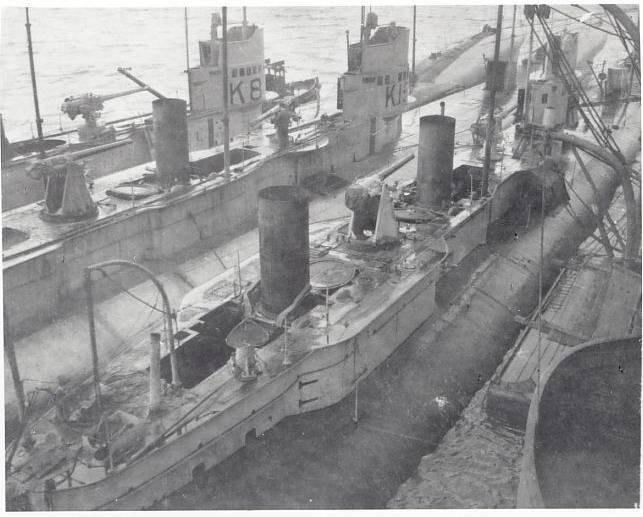
Submarines in the port. You can clearly see the device superstructure and pipes. Photo 477768.livejournal.com
In October, 1917 of the year, a contract for the construction of six submarines on the upgraded project "K". This project involved the replacement of equipment, as well as the processing of weapons. Rotary torpedo tubes were removed from the nose, and six 21-inch (533 mm) tubes were installed in the body. The design of the light hull and deck has changed. Seriously remade auxiliary devices of the boilers. In particular, new chimneys and air intakes were used, the design of which prevented the flooding of water.
According to the improved project, only one submarine was built - HMS K26. Due to difficulties at the construction and testing stage, it was transferred to the fleet only in 1923. The construction of the rest was canceled due to the end of the First World War.
Failures in the service
Already at the stage of sea trials, the first of the constructed submarines of the new project faced serious difficulties. All the main problems of the ship HMS K3 were associated with a special power plant. Thus, for the increased surface speed, we had to pay a high price in the form of insufficient ease of operation, numerous problems, etc.
When steam engines were in operation, the temperature inside the hull rose, and the fans did not always cope with the supply of fresh fresh air. In such modes, it was not the most successful design of the case. At considerable speeds, the boat showed a tendency to sniff out the wave. In addition, the steering mechanisms and the steering wheel itself did not always cope with the tasks assigned to them. The maneuverability of the submarine left much to be desired.
A particular problem was the transition from the surface to the underwater position. Before the dive, the crew had to shut off the boilers and stop the turbines, then shut off a number of pipelines and valves, stack the chimneys and close the holes in the superstructure. After that, it was possible to fill ballast tanks, start electric motors and secretly approach the target. It took about half an hour to carry out all the necessary procedures with proper control. In an emergency, by speeding up the basic procedures, the dive time could be reduced to 5 minutes. However, in combat and this could be unacceptable for a long time.
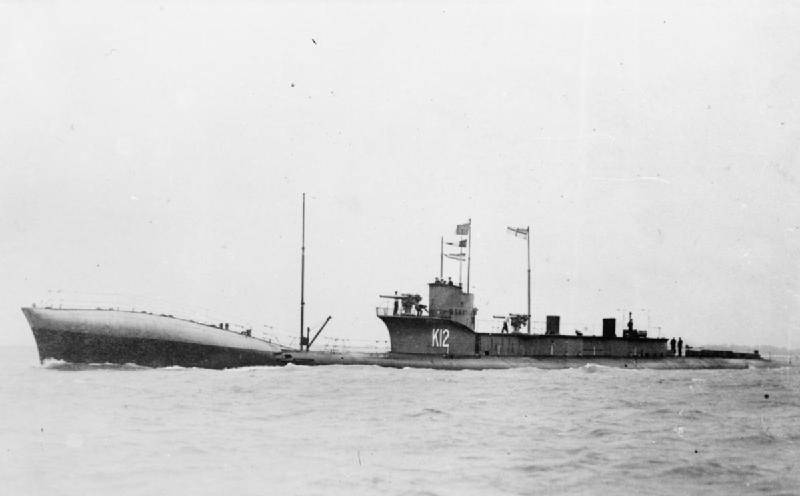
HMS K12 in the sea. Photo of the Imperial War Museum / iwm.org.uk
The K-class submarine did not have the most advanced controls, which, in particular, made it difficult to hold on an even keel. In combination with a large body length and its insufficient strength, this turned into a problem. Thus, with 10 ° trim, the difference between the depths of the nose and stern reached 16-18 m. With 30 ° trim, these figures increased to half the length of the submarine, and the feed was at the maximum depth. Imperfect controls hampered the management of the submarine and worsened maneuverability.
Despite the presence of serious problems, including those impeding the work in the squadron, the submarines of type "K" continued to build and operate. This decision can hardly be considered fully literate and justified. Due to a number of shortcomings, the submarine regularly encountered some difficulties, there were constant accidents. In addition, over the course of several years, the Royal Navy lost several submarines of the series. Under certain circumstances, six ships were killed - a third of all built.
At the end of 1916 of the year (according to other data, already in 1917), the K13 submarine sank during sea trials. Killed 32 man - almost half the crew. The boat fell to the bottom in shallow water, which made it possible to lift it and send it for repair. In October, 1917, she was accepted into the fleet under the designation K22.
18 November 1917 of the HMS K1 and HMS K4 submarines patrolled the North Sea near the Danish coast. Due to insufficient maneuverability and bad weather conditions, the boats collided and K1 was seriously damaged. It was decided to flood the damaged submarine so that it would not go to the enemy. The crew in full force switched to K4, maintaining an acceptable state.
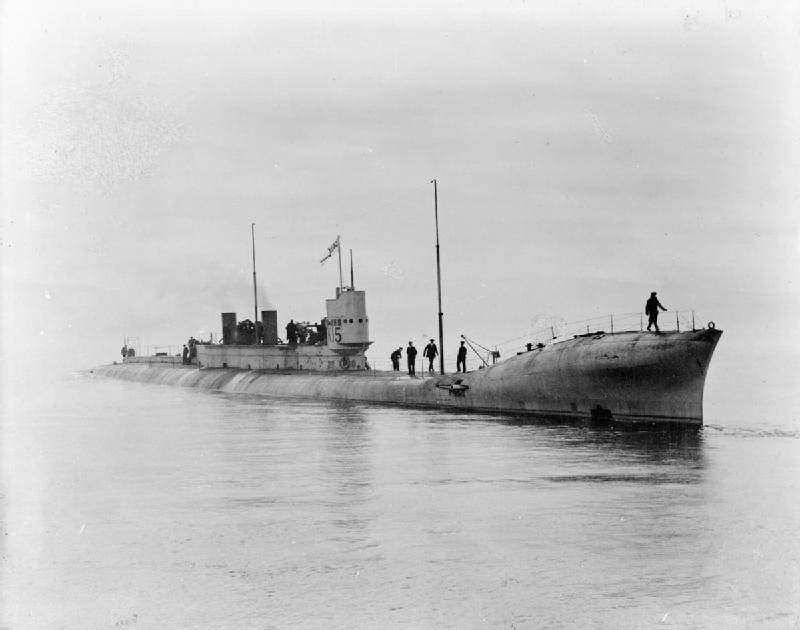
The submarine K15. Photo of the Imperial War Museum / iwm.org.uk
On the night of February 1 1918, the United Kingdom lost two K-type submarines at once and two more required repair. On this day in about. May conducted exercises with the code EC1, the purpose of which was to work out joint actions of surface ships and squadron submarines. Two squadrons of ships and two fleets of submarines, consisting of nine K-class units, took part in the exercises. Due to problems with observation at night and mistakes in navigation, two patrol ships almost collided with the K14 and K22 submarines, but they were able to escape from the collision. However, their maneuver ended in shock. Four battlecruisers followed the submarines; three passed freely, while the fourth hit HMS K22 and inflicted new damage on it. Two damaged submarines managed to return to the base. After repair, they continued to serve.
Another submarine flotilla, upon learning of the collisions, changed course. After that, the submarine K17 from its composition collided with the light cruiser-flagship of the escort squadron HMS Fearless. Several submariners were rescued, but the submarine went to the bottom with the remaining crew. There was also a collision of boats K4 and K6, ending with the death of the first. On HMS K4 no one survived.
The teachings of EC1 ended with the death of two submarines and over a hundred sailors. Two more ships were damaged, part of the submariners needed treatment and recovery. The performance of combat training tasks was disrupted. The ships returned to base. The events of January 31 and February 1 1918 of the year received the ironic name “Battle of the Isle of May”. A thorough analysis of the causes of the tragedy, the course of events and their consequences dealt a serious blow to the concept of squadron submarines. In practice, it was shown that surface and submarine forces in their current form cannot effectively interact in terms of exercises or combat.
During World War I, K-type submarines regularly patrolled and participated in maneuvers. However, until the end of the conflict, they never had to face a real enemy. In addition, squadron submarines have never worked as part of squadrons outside the marine test sites. The combat score of the entire K-class series is zero.
During operation, it became clear that the upper nasal torpedo tubes are subject to the negative effects of waves. They broke down from constant blows and could not be used. In this regard, there was a proposal to abandon such weapons. During routine repairs, unnecessary torpedo tubes were removed from submarines. Instead of their nose cones, smaller, streamlined structures were installed on the nose.
After the war, 20 January 1921, the submarine HMS K5 and its crew were killed. During exercises in the Bay of Biscay, submariners were preparing to dive. They reported this to the command and no longer contacted. On the same day, wreckage of a submarine was found on the surface of the sea. According to the basic version, the submarine sank to an unacceptable depth, which led to the destruction of a solid hull.
In May 1921, the submarine HMS K15 almost died. During the campaign, the wave flooded the air intake devices of the steam engine. Several compartments were partially flooded, but the crew coped with the accident and was able to wait for help. On the night of June 25 of the same year, K15 still went to the bottom, and this happened near the pier in Portsmouth. During the day there was warm weather, which caused the heating and expansion of the working fluid in some hydraulic systems. At night, the oil cooled and, by moving the pistons in the cylinders, opened several air vents through which water got into the hull. Fortunately, no one was hurt. It was only possible to lift the boat to the surface in 1924. Since that time, the construction suffered from external factors, and the remains of the ship were sent to the smelter.
In the early twenties, the Royal Navy began to write off the K-class submarines, and at this stage it was not without problems again. So, in the 1922, the K10 submarine was towed for cutting. During this trip, a hull depressurization occurred, as a result of which the boat sank.
It should be noted that during the service of the submarine of the type "K" faced with other troubles that did not always lead to the death of people and equipment. There are many cases where ships were aground, sinking below the permissible depth or other disasters suffered. These facts are reflected in the marine folklore. Submariners began to decipher the letter “K” as Kalamity (distorted “Disaster”) or Killer (“Killer”). They called themselves the "suicide club".
From 1920, the command began to get rid of unsuccessful and sometimes even dangerous submarines of type "K". The K16, one of the last submarines of the series, was the first of the fleet to be withdrawn. New agreements on the sale and cutting of submarines were signed in 1921, 1923 and 1926 year. Of the ships of the base modification, HMS K2, HMS K6 and HMS K22 served the longest - they were sent for scrap only in the 1926 year.
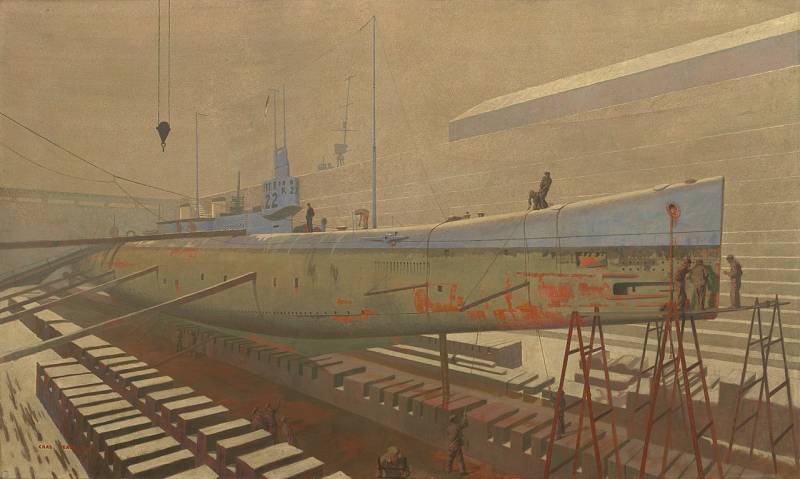
K13 / K22 during repair, possibly after flooding, is under test. Figure Imperial War Museum / iwm.org.uk
The only representative of the modernized project “K” - HMS K26 - remained in the ranks until the early thirties. The improved design saved the sailors from the mass of problems that had occurred on previous submarines, which contributed to a long and relatively successful service. K26 was written off only in 1930 year in connection with the signing of the London Maritime Treaty. This agreement prohibited submarines with a displacement of more than 2000 tons. The project “K” as a whole did not comply with these restrictions, but by the time of signing the agreement only one of its representatives remained in the ranks. The following year, K26 was cut into metal.
Concept killers
Squadron type “K” submarines were not the most popular in the Royal Navy, nor did they manage to become at least somewhat successful. Moreover, of the 18 ships built, 5 died during service and another sank after decommissioning. The series earned notoriety and a lot of unpleasant nicknames. It is not surprising that the Admiralty began to get rid of the unsuccessful and dangerous K-class boats at the first opportunity.
Despite a lot of failures and death of people, the K project in practice revealed a number of issues related to the development of submarines. In the first place, these ships demonstrated that the boiler-turbine power plant should not be used on submarines for a variety of reasons. In addition, the difficulties associated with the construction of long submarines of a relatively large displacement were shown. All boats of type “K” had problems with controllability, and this should be taken into account in the new project.
But perhaps the main result of the K project was the rejection of an unviable concept. All story the operation of such boats and in particular the “Battle of Fr. May "clearly showed that the idea of a squadron submarine does not make sense. The level of technology development at the time did not allow creating effective means of navigation, communication and control capable of ensuring the normal cooperation of surface ships and submarines. The lack of such funds, in turn, posed a danger to the material, health and life of seafarers.
Unsuccessful in all respects squadron type "K" submarines served in the British fleet just a few years. They were accepted into service in 1916-18, but already in 1920 they began to write off. The main result of the development and operation of such submarines was the understanding of several important facts. The disadvantages of the K-class boats began at the concept level, which led to the well-known results. The Admiralty took into account the mistakes made and did not repeat them further. Unsuccessful developments under the project “K” did not find application in the creation of the subsequent series of submarines.
On the materials of the sites:
https://battleships-cruisers.co.uk/
https://militaryfactory.com/
https://warisboring.com/
http://public.navy.mil/
http://rnsubs.co.uk/
https://military-history.org/

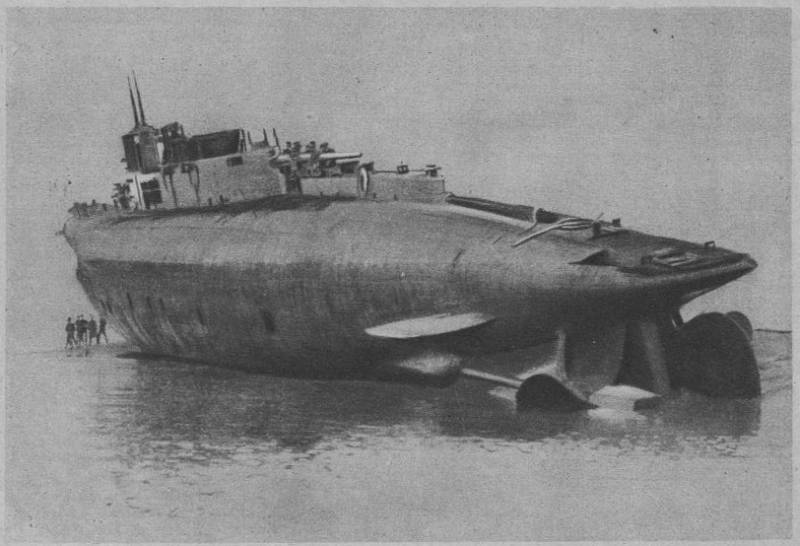
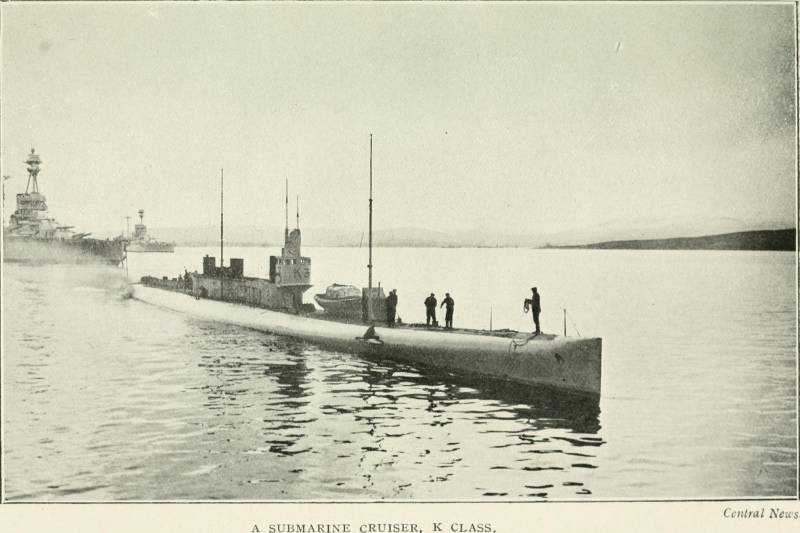
Information